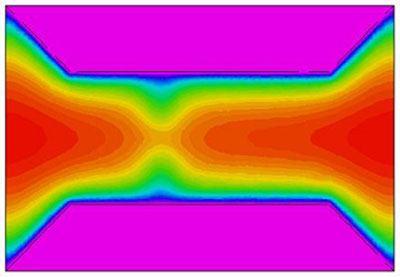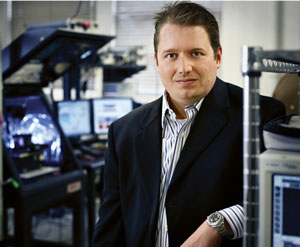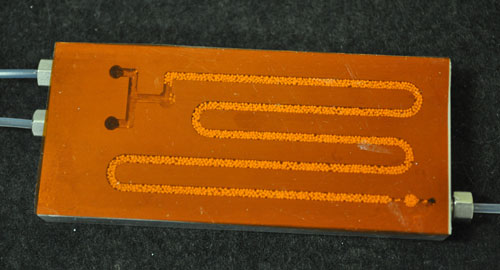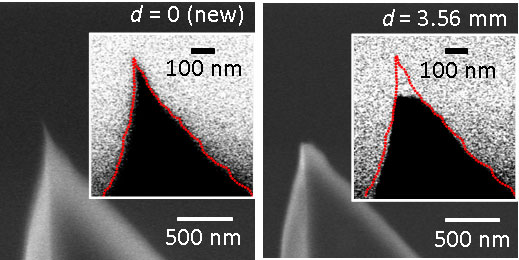Electrons set free
 Free-floating electrons on top of liquid helium yield insights into their transport behavior.
Free-floating electrons on top of liquid helium yield insights into their transport behavior.
Apr 1st, 2011
Read more
 Free-floating electrons on top of liquid helium yield insights into their transport behavior.
Free-floating electrons on top of liquid helium yield insights into their transport behavior.
Apr 1st, 2011
Read moreScientists described development and successful initial tests of a spray-on material that both detects and renders harmless the genre of terrorist explosives responsible for government restrictions on liquids that can be carried onboard airliners.
Apr 1st, 2011
Read moreNew method allows for more precise control over ATRP, a popular technique used for creating specialized plastics.
Mar 31st, 2011
Read moreA team of engineers at the Yale School of Engineering and Applied Science has created a new fuel cell catalyst system using nanowires made of a novel material that boosts long-term performance by 2.4 times compared to today's technology.
Mar 31st, 2011
Read moreDo the principles of quantum mechanics apply to biological systems? Until now, both biologists and physicists have considered quantum systems and biological molecules to be like apples and oranges. But new research definitively shows that a biological molecule - DNA - can discern between quantum states known as spin.
Mar 31st, 2011
Read more Lynford L. Goddard, an assistant professor in electrical and computer engineering, has received a National Science Foundation (NSF) CAREER Award, for his project, entitled, "Theory and Application of Reflective Microring Resonators".
Lynford L. Goddard, an assistant professor in electrical and computer engineering, has received a National Science Foundation (NSF) CAREER Award, for his project, entitled, "Theory and Application of Reflective Microring Resonators".
Mar 31st, 2011
Read more Industry is eager to harness the potential of micro-technology, but has been unable to do so for most consumer products because of the high manufacturing cost.
Industry is eager to harness the potential of micro-technology, but has been unable to do so for most consumer products because of the high manufacturing cost.
Mar 31st, 2011
Read more Using a small block of aluminum with a tiny groove carved in it, a team of researchers is developing an improved "green chemistry" method for making biodegradable polymers. Their recently published work is a prime example of the value of microfluidics, a technology more commonly associated with inkjet printers and medical diagnostics, to process modeling and development for industrial chemistry.
Using a small block of aluminum with a tiny groove carved in it, a team of researchers is developing an improved "green chemistry" method for making biodegradable polymers. Their recently published work is a prime example of the value of microfluidics, a technology more commonly associated with inkjet printers and medical diagnostics, to process modeling and development for industrial chemistry.
Mar 31st, 2011
Read more Scientists at the National Institute of Standards and Technology (NIST) have developed a way to measure the wear and degradation of the microscopic probes used to study nanoscale structures in situ and as it's happening. Their technique can both dramatically speed up and improve the accuracy of the most precise and delicate nanoscale measurements done with atomic force microscopy (AFM).
Scientists at the National Institute of Standards and Technology (NIST) have developed a way to measure the wear and degradation of the microscopic probes used to study nanoscale structures in situ and as it's happening. Their technique can both dramatically speed up and improve the accuracy of the most precise and delicate nanoscale measurements done with atomic force microscopy (AFM).
Mar 31st, 2011
Read moreChristian Spielmann receives Thuringian Research Award
Mar 31st, 2011
Read moreThe next-generation battery, like next-generation TV, may be 3-D, scientists reported at the 241st National Meeting and Exposition of the American Chemical Society (ACS). They described a new lithium-ion (Li-ion) battery, already available in a prototype version, with a three-dimensional interior architecture that could be perfect for the electric cars now appearing in auto dealer showrooms.
Mar 31st, 2011
Read moreCompleting the story they started by creating synthetic magnetic fields, scientists from the Joint Quantum Institute (JQI) have now made atoms act as if they were charged particles accelerated by electric fields.
Mar 31st, 2011
Read more Researchers from the National Institute of Standards and Technology (NIST) and the University of Maryland have created the first nontrivial "atom circuit", a donut-shaped loop of ultracold gas atoms circulating in a current analogous to a ring of electrons in a superconducting wire.
Researchers from the National Institute of Standards and Technology (NIST) and the University of Maryland have created the first nontrivial "atom circuit", a donut-shaped loop of ultracold gas atoms circulating in a current analogous to a ring of electrons in a superconducting wire.
Mar 31st, 2011
Read more$10.8 million will be shared with scientists and engineers at 18 academic institutions.
Mar 31st, 2011
Read moreMore than 300 middle- and high-school students from throughout New York received a firsthand look at careers in the emerging field of nanotechnology when they visited the UAlbany NanoCollege and its $7 billion Albany NanoTech Complex.
Mar 31st, 2011
Read moreAs part of the quest to form perfectly smooth single-molecule layers of materials for advanced energy, electronic, and medical devices, researchers at the U.S. Department of Energy's Brookhaven National Laboratory have discovered that the molecules in thin films remain frozen at a temperature where the bulk material is molten. Thin molecular films have a range of applications extending from organic solar cells to biosensors, and understanding the fundamental aspects of these films could lead to improved devices.
Mar 30th, 2011
Read more